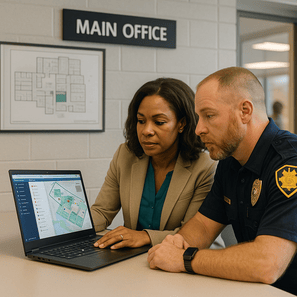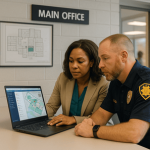
If you lead a school, you already juggle academics, staffing, family communication, and a dozen emergencies that were not on the calendar. Security technology should make your day easier, not harder. That is why more districts are moving from a mix of standalone tools to integrated school security where access control, video, visitor management, intercom, and emergency alerts work as one system.
This guide explains what integrated safety looks like in practice, how to get there without disruption, and how to measure real impact on campus safety.
j
j
What integrated school security really means
Integration is more than placing different logos on one screen. It is the ability for systems to share data and trigger actions across platforms in real time.
-
A panic alert triggers a lockdown of exterior doors and sends instructions to staff
-
A forced door alarm automatically pulls nearby camera views and logs the event
-
A visitor check in issues a time bound credential and routes the guest by digital signage
-
A single dashboard shows door status, active alerts, priority cameras, and who is responding
The goal is simple. Faster awareness and faster action with less guesswork.
j
j
Core building blocks of an integrated safety stack
Access control
Role based permissions, schedules, remote lock and unlock, and audit trails. Focus on perimeter doors, main office, server rooms, and any space used after hours.
Emergency alert systems
Silent panic buttons on mobile, desktop, or wearable devices. Zone based notifications for classrooms, gym, or auditorium. Clear plain language templates for staff, students, and families.
Video surveillance and analytics
Cloud based cameras for entries, lobbies, stairwells, and parking. Smart search, motion bookmarks, and quick clip sharing with responders.
Visitor management
Digital check in with ID scan, watchlist checks, photo badges, and automatic access limits during the visit window.
PA and digital signage
Pre built voice messages and on screen instructions that match your protocols. Visual cues are essential in loud spaces.
Unified dashboard
One secure portal with maps, live tiles, alerts, and reports so principals and SROs see the same picture.
j
j
Three everyday scenarios that show the value
Scenario 1. Door propped during dismissal
Access control reports a door held open. The dashboard highlights the camera at that entry, records the clip, and notifies the front office. Staff close the door and log the resolution without leaving the screen.
Scenario 2. Medical emergency on the field
A coach uses a mobile panic button. The system alerts administrators, displays the AED locations on the map, and opens the closest vehicle gate for EMS. Post event, the report shows timeline and responders.
Scenario 3. After hours auditorium rental
Visitor management pre registers the group. Time limited credentials unlock only the lobby and auditorium. Cameras cover entry routes. An alert from the event lead notifies on call staff and locks academic wings.
j
j
A practical roadmap to integrate without ripping and replacing
-
Map what you have
List doors, cameras, alert tools, intercoms, and who uses them. Capture device counts, software versions, and contract terms. -
Choose the system of record
Decide which platform will be the primary source for users and roles. Many districts start with access control as the anchor. -
Prioritize the first four integrations
Access plus alerts, access plus video, visitor plus access, alerts plus signage. These deliver the fastest wins. -
Standardize credentials and naming
Adopt one format for badges or mobile IDs and a common naming scheme for doors and cameras. Clarity saves minutes during a crisis. -
Pilot on one campus and one wing
Prove workflows with a small footprint. Document what works and update your playbooks before scaling. -
Train by role in short sessions
Front office, teachers, coaches, custodial, and SROs each need only what they will actually use. Keep training under fifteen minutes. -
Measure and iterate
Track alert to action times, door prop frequency, false alarm counts, and camera uptime. Review monthly with a short scorecard.
j
j
Governance, privacy, and student trust
Integrated does not mean all access for everyone. Protect your community with simple rules.
-
Role based permissions and least privilege as defaults
-
Written retention and sharing policies for video and logs
-
FERPA aware processes for requests and redactions
-
Clear family communication about what is monitored and why
-
Annual audits of permissions, devices, and documented drills
Trust grows when policies are clear, consistent, and easy to explain.
j
j
Budget tips and grant alignment
You do not need to fund everything at once. Phase projects in ways that also strengthen grant applications.
-
Start with perimeter access and main office visitor flow
-
Add mobile panic alerts to meet Alyssa’s Law where applicable
-
Upgrade critical camera views and retire the oldest recorders
-
Use data from incidents and drills to justify funding requests
-
Standardize on cloud based platforms to reduce server costs
Grants often favor projects that improve notification reach, reduce response time, and document results. Integrated systems do all three.
j
j
What to put on your dashboard home screen
-
Live alert panel with acknowledge and resolve buttons
-
Campus map with door states and key camera tiles
-
Quick actions for lockdown, shelter, and all clear
-
Most recent visitor check ins and late staff entries
-
System health for devices, batteries, and network status
If it does not help you act in the next two minutes, it belongs on a secondary tab or report.
j
j
Common pitfalls and how to avoid them
-
Too many vendors and no clear owner
Assign a single internal owner and a single external integrator. -
Fancy features nobody uses
Configure only the buttons and views staff need during the first rollout. -
Training once and never again
Refresh training at semester start and after staff turnover. -
No follow up after drills
Log times, capture clips, and meet for ten minutes to pick one improvement.
j
j
How SSP supports integrated school safety
SSP designs, installs, and supports integrated school security systems that connect campus access control, emergency alert systems, video surveillance, visitor management, and PA and signage into one clear picture. We help you standardize the tech stack across old and new buildings, train your team by role, and measure results with simple dashboards and reports.
Want a quick integration plan for your campus
Request a no cost walkthrough. We will map your doors, cameras, alerts, and visitor flow, then outline a phased plan that fits your budget and timeline.


